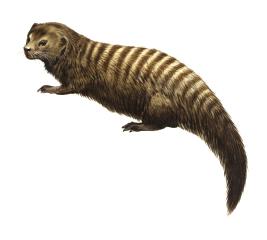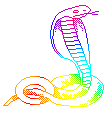Cobra Information Page 6 |
The cobra's enemies |
 |
|
BELOW: Mongooses are famous for their snake-fighting ability, and are almost always victorious because of their speed, agility, and timing and also because of their thick coat. |
 |
Cobra Information Page 6 |
The cobra's enemies |
 |
|
BELOW: Mongooses are famous for their snake-fighting ability, and are almost always victorious because of their speed, agility, and timing and also because of their thick coat. |
 |
Mongooses are small carnivores of the family Viverridae. The true mongooses make up the subfamily Herpestinae and include 13 genera and about 30 species, almost all native to Africa. The Madagascan mongooses, a second group, constitute the subfamily Galidiinae and consist of 4 genera and 7 species. In addition, some of the banded palm civets, subfamily Hemigalinae, are also known as mongooses, including the Bornean mongoose, Diplogale, and the Madagascan small-toothed mongooses, or falanoucs, Eupleres. Conversely, certain mongooses are popularly called suricates, meerkats, cusimanses, or ichneumons. Mongooses typically have a pointed head, a long tail, and thick hair except on the lower legs. They are commonly terrestrial, diurnal, and solitary. The suricate, Suricata suricatta, of southern Africa, however, lives in colonies; the African marsh mongoose, Atilax paludinosus, is semiaquatic; and the little-known Madagascan mongoose, Galidia, can be found in trees. Mongooses feed on a wide variety of foods, including small mammals, reptiles, birds' eggs, and insects. Among the better-known mongooses are those of the genus Herpestes, which range from southern Europe into Africa and southern Asia. The Indian gray mongoose, H. edwardsi, which may reach 50 cm (20 in) long plus a 41-cm (16-in) tail, and weigh about 2.3 kg (5 lb), is the one portrayed in Kipling's Jungle Book. The similar gold-spotted mongoose, H. javanicus or H. auropunctatus, was introduced into the Hawaiian Islands and to the West Indies and other Caribbean islands to control rats and snakes; although it did feed on rats and snakes, it concentrated on and seriously depleted populations of native birds and mammals. Mongooses of this genus are famous for their snake-fighting ability and are often portrayed fighting a cobra. Research has shown that although the mongoose is tolerant of small dosages of cobra venom, it is not immune to it. Mongooses are almost always victorious because of their speed, agility, and timing and also because of their thick coat.
The ratel {rayt'-ul}, or honey badger, Mellivora capensis, in the weasel family, Mustelidae, is a carnivore that lives in brushlands and forests of Africa, India, and the Middle East. Its thick coat is gray above and black below. The skin is loose but very tough. The animal is about 60 cm (2 ft) long, excluding its tail, and is a good climber, living in trees as well as in burrows. It likes honey, and the HONEY GUIDE, or indicator bird, leads it to the nests of wild bees. The ratel also feeds on rodents and reptiles, even the cobra.
Man is one of the cobras' most dangerous enemies. Unlike the ratel
and mongoose, whose small numbers and chance at loosing the fight create
a natural balance, man captures the Cobra with relative impunity. Cobra
skins are one of the most highly prized of the exotic leathers, commanding
prices as high as two-hundred US dollars. It is said that "a cobra hunter
always returns victorious" (because if unsuccessful, they do not return).
Since cobras naturally maintain high populations in Asian countries, no
protective legislation has ever been proposed. Only in Egypt, where the
Egyptian Asp is revered as a religious symbol are cobras protected in any
way. Due to their deadly nature, import/export of cobras is closely controlled
in every civilized nation in the world. Many types of cobras, usually with
their venom removed, are available through various black markets around
the world. Banded cobras, or asps, are fairly readily available through
the south eastern United States black market. Saudi royalty is said to
have a thriving stock of cobras for use as pets, but this is unconfirmed.
|
|
|
|
|
|
|
|
